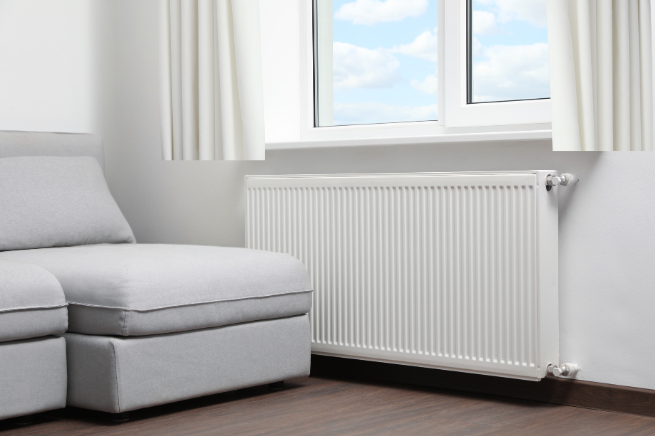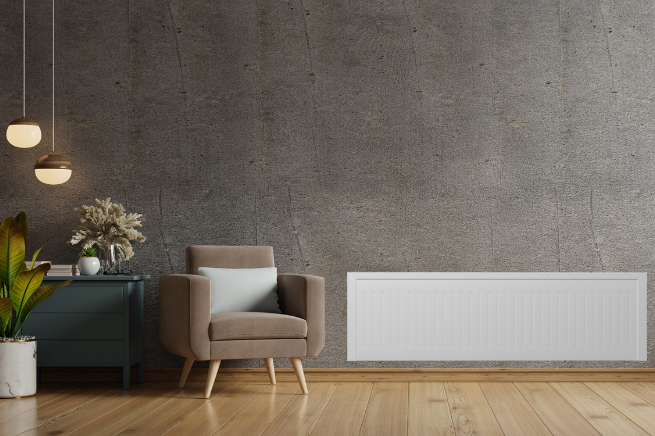
Are you tired of those sky-high electricity bills eating away at your hard-earned money? Well, you’re not alone. In today’s world, where every penny counts, finding ways to reduce our energy consumption isn’t just good for our wallets – it’s great for the planet too. So, let’s roll up our sleeves and dive into some game-changing energy-saving tips that’ll have you seeing green in more ways than one!

Let’s address a costly habit: covering your radiators. While long curtains and custom radiator covers may look great, they’re actually blocking your heat. Imagine your radiator as a shy speaker trying to deliver warmth. If you place barriers like curtains or covers, it struggles to reach its audience—your cold feet.
Curtains: When long curtains drape over radiators, they trap the heat between the window and the fabric. We can’t forget they may also introduce fire hazards, which no one wants!
Radiator Covers: While they might look nice, poorly designed covers can reduce a radiator’s heat output by up to 40%. That’s like paying for a full tank of fuel but only being able to use 60% of it!
So, what’s the solution? It’s simpler than you might think:
Keep your curtains away from your radiators - opt for short ones, or maybe even blinds.
If you really want a radiator cover, try to find one designed to promote heat circulation, these tend to have open slats to let the heat flow.
By giving your radiators room to breathe, you’re not just improving their efficiency – you’re ensuring that the heat you’re paying for actually ends up doing what you want it to: warming your home up!
Now, let’s talk about something that’s often out of sight and out of mind, but incredibly important: insulation. Good insulation acts like a temperature forcefield around your house. It’s like a sweater in the winter - preventing heat from escaping away from your home, therefore meaning that your radiators don’t need to work as hard, ultimately leading to lower energy bills. Then, in the summer, it prevents hot air from seeping into your home. Therefore, it works for your benefit all year round, so we believe it is most definitely worth investing in!
So, where should you focus your insulation efforts? Let’s break it down:
Attic: This is the big one!. Did you know that up to 25% of your home’s heat can escape through a poorly insulated attic? It’s like leaving a quarter of your windows wide open in the middle of winter!
Walls: Cavity wall insulation can save you up to 15% on your heating bills. That’s like getting a 15% raise, but instead of more work, you just get a cosier home!
Floors: Especially important for homes with basements or crawl spaces. Insulating your floor can save you another 10% on your heating bills.
Windows and Doors: Draft-proofing these areas can save you another 10%. It’s like plugging all the little holes in your energy bucket. Adding to these drafts is keyholes! For how small they are, these pesky little holes let an immense amount of air through so they’re another major thing to consider when blocking drafts.
Now, I know what you’re thinking – “This sounds like a big job!” And you’re right, it can be. But here’s the good news: you don’t have to do it all at once. Start with the easiest areas, like sealing drafts around windows and doors. You can use weather stripping or even roll up a towel to block drafts under doors. It’s a simple DIY project that can make a noticeable difference on your homes heat and energy bills.
For bigger jobs like attic or wall insulation, it might be worth calling in the professionals. Yes, there’s an upfront cost, but the long-term savings could be substantial. Plus, many areas offer incentives for improving your home’s energy efficiency, meaning the government can help you make your home cosy.
Now we know that your old appliances might be loyal soldiers, but they’re fighting a losing battle when it comes to energy efficiency and your electricity bills. It’s time to combat this and consider some new, modern, energy-efficient appliances. I know what you’re thinking - “New appliances sound expensive!” But while there may be an upfront cost, the long-term savings could definitely make it worth it.
Refrigerators: Modern fridges use about 40% less energy than models from the early 2000s. That’s like getting a 40% discount on your fridge’s running costs – every single day!
Washing Machines: Energy-efficient washers use about 25% less energy and 33% less water than regular washers. That’s a win-win for your enegry bills and the environment.
Dishwashers: ENERGY STAR certified dishwashers are about 12% more energy efficient and 30% more water efficient than standard models. Now that’s something to raise a (clean) glass to!
Radiators: Common ‘older’ radiator models don’t work effectively and efficiently. Electric heating options are 100% efficient as they convert every KW of electricity into heat. The NEOS takes this one step further and has a patented design, enabling it to perform more effectively when delivering heat to your home. This is due to quadvex convection, our patented cool wall technology and the unique soapstone core, which work together to heat your space up quicker.
Want more information on this? We’ve tested the NEOS alongside other electric heating options through a knowledge transfer partnership with the University of Huddersfield and put it together in an easy to follow running cost guide!
Now that we’ve covered those bigger items, let’s talk about something that doesn’t cost a penny but can make a huge difference: your daily habits.
The Great Unplugging: Did you know that many electronics continue to draw power even when they’re turned off? This can account for up to 10% of your home’s energy use. The solution? Unplug devices when you’re not using them.
Thermostat Tactics: Every degree matters when it comes to heating and cooling. In winter, try setting your thermostat a degree or two lower than usual and bringing out those blankets that are probably just acting as a decoration at the minute. Making the most of your thermostats also involves using the scheduling functions. Matching your heating to your lifestyle ensures that you’re not wasting money by heating rooms that aren’t being used.
Laundry: Your washing machine and dryer are energy hogs, but you can tame them with a few simple tricks. Wash clothes in cold water whenever possible (modern detergents work just fine in cold water), and always wash full loads. For drying, clean the lint filter after every use to improve efficiency, and consider air-drying clothes when weather permits.
Natural Climate Control: In summer, close blinds and curtains during the day to keep out the heat. In winter, open them to let in warming sunlight.
The Power of Off: This might seem obvious, but it’s worth repeating: turn off lights and appliances when you’re not using them. It’s the simplest habit, but it can make a big difference.
Now, I know what you’re thinking – “These all sound great, but will I really remember to do them?” Here’s a tip: start with one or two habits and make them part of your routine. Once they become second nature, add another. Before you know it, you’ll be an energy-saving superhero without even thinking about it! What’s better is, you can turn off your NEOS radiators wirelessly and through app control if you really can’t be bothered getting out of bed!

If you remember just one takeaway from this blog, let it be this - every little bit helps. You don’t have to implement all of these tips, and you certainly don’t need to implement them all at once. Why don’t you start by unplugging items when you’re not using them? As soon as you see the savings start, you’ll no doubt be motivated to do more. The motivation to start making these changes can be hard so consider making it a family challenge. Maybe set us a leaderboard of who turns off the most appliances or collect all that saved money for a fun family day out.
Another key point to remember is that reducing your electricity usage isn’t just about saving money. It’s about being more sustainable, responsible, and reducing your carbon footprint in the hopes of a greener future.
So, are you ready to start your energy-saving adventure? Of course you are! And remember, we’re always here to help. If you have questions about energy-efficient heating solutions for your home, or if you want to learn more about how our products can help you save, don’t hesitate to reach out and give us a call or send us an email at [email protected] . Together, we can create a more energy-efficient future, one home at a time.
Tags: General Guides, Tips.

If you are considering electric heating/electric radiators, then this guide tells you everything you need to know. Discover this modern, sustainable and economical method of heating that gives you complete control and comfort. Download Free Guide now.

*Trust Electric Heating needs the contact information you provide to us to contact you about our products and services. You may unsubscribe from these communications at any time. For information on how to unsubscribe, as well as our privacy practices and commitment to protecting your privacy, check out our Privacy Policy.
Quick installation and a 100 day warmth guarantee. Whether you’re buying one or several radiators, if our radiators don’t heat your room to a minimum of 20 degrees we will undertake to upgrade or replace the radiators free of charge.
Book your free consultation